Inflated gains: MotoGP makes important airbag safety step in 2018

There is only so much protection afforded to a MotoGP rider at speeds of more than 220mph and perhaps this is part of the slightly macabre and time-honoured appeal of motorcycle racing. The vulnerability of the athletes whom manfully throw prototype machines of brutal power around 19 racetracks a year is also part of the sensational and visceral edge of the sport.
While F1 tentatively ventures into a new age of safety with "halos" around the cockpit, MotoGP is taking its own steps with an obligatory form of protection that has been making large in-roads in terms of development and efficiency in the last 15 years; even if the same measure has long been present in the most basic of consumer cars for decades.
For 2018 and the fresh season that begins this weekend under floodlights at the Losail International Circuit in Qatar, the Fédération Internationale de Motocyclisme (FIM) has decreed that airbags have to be a compulsory component of every rider’s racing suit.
For most of the top-level racers the kind of rapid-firing and intelligent software and hardware pioneered by companies such as Alpinestars and Dainese since 2001 have been commonplace - and gladly received - for a number of seasons anyway.
With almost 50 riders in the premier class of Grand Prix (including world champion Marc Marquez), Asolo-based Alpinestars of Italy has been the vanguard for the airbag and for a unit that is a small, light and integral (yet modular) part of a suit and works independently of the motorcycle.
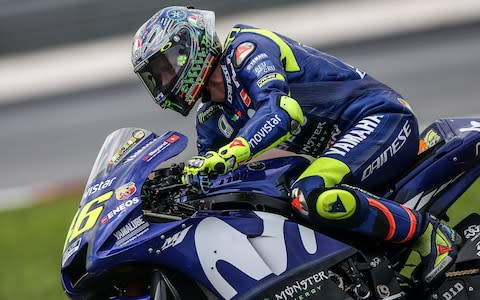
Customer street versions of airbags were available for motorcyclists as early as the 1990s but were cumbersome, restrictive and questionable devices. Thanks to associations with some of the cream of motorcycle racing talent Alpinestars has been able to produce its ‘Tech-Air’ system, launched on the general market in 2014.
Fellow Italian form Dainese was already running a Procom ‘digital’ suit in 2001 that would collect valuable data on a rider’s vital signs and behaviour thanks to more than 60 sensors. The progression to airbags and the capability to predict a crash through complex algorithms was a whole different level - and one that has saved the skin and organs of the riders who have guinea-pigged the ideas.
Valentino Rossi says: “In the beginning, I think around 2009, Dainese start to bring it [the airbag] after a long study but I didn’t feel comfortable because I lost some movement and gained some weight.
“It was too big. But from that moment they are able to improve a lot, and now, sincerely, I don’t want to go on the track without the D-Air. For me it is a great step for the safety, especially for the shoulders, for the collarbones.”
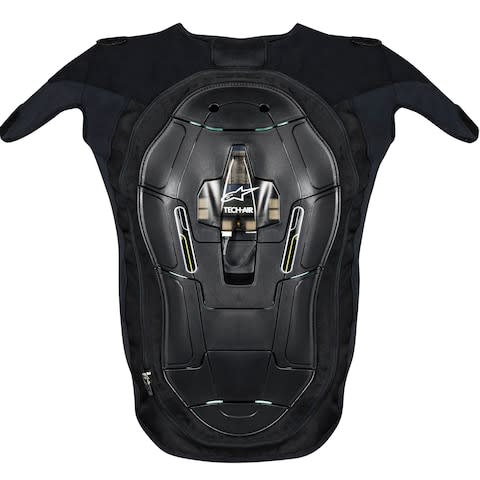
As one of Alpinestars’ premier riders, three-time World Superbike Champion and BBC Sports Personality runner-up Jonathan Rea has also been asked to contribute to the fast evolution. He says: “As a rider you are always searching for marginal gains so when Alpinestars first came to me about the airbag I thought about it in the wrong way: I believed it would be added weight. I’m not sure how many grams extra it was but they convinced me, and the suit fitted like a glove the first time I put it on. I think it is only 600 grams.”
Tech-Air is a close fitting vest with an ECU ‘hub’ and works by a sophisticated algorithm that detects the initial phases of a crash and ignites canisters and inflates airbags in 45 milliseconds (0.045 of a second).
The padding offers full upper body protection for back, shoulders, kidney area, chest and upper abdomen. The unit is independent of the bike, can be fired twice without reset or recharge, does not rely on GPS and can be configured through a system firmware swap for either the track or the street.
The computer data required to almost ‘predict’ a crash (as opposed to an out-of-saddle moment) is highly complex and has been accumulated and coded since Alpinestars first began its R&D in racing back in 2001. In this way it is different to a car airbag, which is triggered by the first phases of impact.

“We feel that we are just beginning to see the full potential of the technology,” says Alpinestars commercial manager Jeremy Appleton. “In the past there simply wasn’t the components or the electronics to start an airbag programme. We had to start over from zero and when we looked at the automotive sector nothing was really transferable.
“I think it is reasonable to say that it is the most complex bit of engineering that we have done and probably is for anybody in our sector because it really is still so new.
"A lot of it is in the algorithms and it was a different type of technology for us. We had to set up an electronics unit and separate staff to build this and take it further. There is a more ‘hidden’ element to it compared to your standard protection item, but when it goes off then you see exactly how much protection it gives.”
It has proved effective for arguably Britain’s leading prospect in MotoGP, Cal Crutchlow, who has been an advocate for four years and logged a hefty 26 crashes in 2016 (more than 80 in the last five years) without injury.
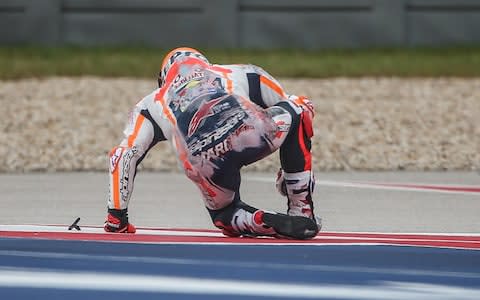
“I’ve been testing it since 2014: different comfort, different ways of deployment and different thresholds,” the 31-year-old Briton says. “Alpinestars has so many guys on tracks around the world that this is why they have been able to develop it so fast. We get new and updated stuff all the time.
“I know it cannot go over the whole body but it used to be over the shoulder, top of the arm and down the ribs. Now we also have our hips and legs [protected]. The way it works is superb and it has definitely saved me and other riders from broken bones.”
Something like Tech-Air won’t be cheap, and the cutting-edge nature of the device will naturally involve some scepticism. However, the simple fact that MotoGP and Superbike stars have been rolling down a stretch of asphalt at up to four times the UK speed limit counts for a lot. And is reinforced by the FIM’s confidence to slot the protection into the sport’s rulebook.
“It shouldn't be an issue,” voices Crutchlow. “It’s like buying a car with an airbag. I spoke to my shoulder surgeon, who I have used for many years like many cyclists and other riders. I asked him how business was going and whether he’d had many clients in recently and he joked he was pi**ed off that the airbag had come along!
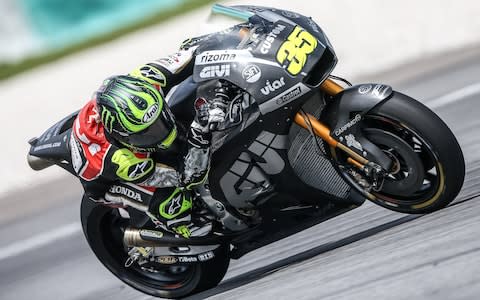
"I think there was only a 50% rate of people who crashed and escaped a broken collarbone, and with the airbag it went up to 90% because it deploys so well.”
Rea recalls: “The first time it went off for me was at the Lausitzring [Germany] in 2016, and it saved my championship. The bike found a false neutral and pretty-much catapulted me into the ground on my left shoulder and I’m 100% sure it would have caused damage if I didn't have the airbag.
"Generally when you have a crash there is a ‘tumble-drier’ effect due to the g-forces and you wake up the next morning feeling a bit battered; the airbag takes a lot of that away. A lot of that muscle soreness.
"When it goes off then it’s the last thing you think about. I tend to freeze a bit when I’m crashing and close my eyes waiting for what’s to come. So you don't really know it has gone off. Then you pick the bike up and you are like this [mimes an inflated profile] so you know it has worked. It has saved my ass a few times.
“We race in a controlled environment and of course we are pushing limits but on the street, where anything can happen, even without you making a mistake, I couldn't recommend it enough,” he adds.

MotoGP is a window of awareness for Alpinestars as much as it is a test-bed. “First and foremost we have to tell people that airbags exist and they are a practical solution,” says Appleton. “The biggest difficulty in terms of communicating about it is that until you crash - or we simulate something - then you cannot see or understand what it looks like and what it can do.
“As a concept I think people ‘get it’ because most of us have cars with airbags,” he continues. “Fundamentally the message is that a legitimate, everyday system exists that you can wear while riding. If you crash or have an impact it will give you an enormous amount more torso protection than any of the passive protection currently available.
"When we get into the real detail of the technology – how and why does it work and what can it offer – then the subject becomes more complicated but ultimately it comes down to how much people want to grasp it.”
Tech-Air and D-Air clearly function (Rea: “It is one of those last-minute checks for me now. It has got to the point where if the battery was dead then I wouldn't ride because I believe in it so much”) but where can the technology progress further to offer even more to the consumer?
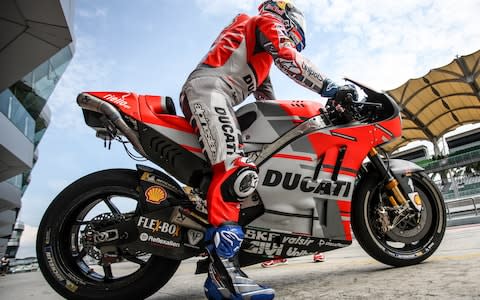
“The way the technology is evolving means that it will become more compact, not in terms of airbag coverage because that will only grow, but the system itself,” offers Appleton. “In MotoGP we are already making significant steps in terms of packaging and in that sport if we can shave mere grams off the product then the teams and riders like that.
"Another objective is to always make the system more ‘capable’. We have new electronics and we are finding new algorithms all the time. So it is like any form of technology in that it’s a process.
"The future? Maybe lighter and more compact in terms of componentry, a larger airbag and being more accessible to the market.”
Advances in materials and performance of suits, boots, gloves and helmets (the fight against rotational acceleration and concussion thresholds is the next great safety barrier and the FIM has an action group working with helmet manufacturers for several years already) and even neck protection, with a company like Leatt trialling a road race unit, mean that the phenomenal motorcycles on track in Qatar this weekend won’t be the only sphere of futuristic focus.
For tips and advice, visit our Advice section, or sign up to our newsletter here

 Yahoo Sport
Yahoo Sport 





































